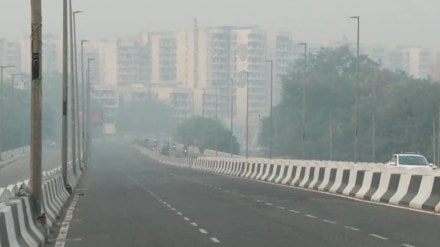Air pollution in Delhi and its neighboring areas remained in the ‘very poor’ category on Monday, according to the Central Pollution Control Board (CPCB). The overall Air Quality Index (AQI) in the national capital was recorded at 333 on the morning of Diwali.
#WATCH | Visuals from the India Gate as GRAP-2 invoked in Delhi.
The Air Quality Index (AQI) around the India Gate was recorded at 347, in the 'Severe' category, in Delhi this morning as per the Central Pollution Control Board (CPCB). pic.twitter.com/5gbpOvT5hp
— ANI (@ANI) October 20, 2025
For context, an AQI of 0–50 is considered ‘good’, 51-100 ‘satisfactory’, 101-200 ‘moderate’, 201-300 ‘poor’, 301–400 ‘very poor’ and 401-500 ‘severe’.
Area-wise AQI
On Monday, October 20, at 7:00 AM, the air quality across Delhi and its surrounding areas remained a serious concern. The CPCB reported that several parts of the national capital were experiencing extremely high levels of air pollution, with the AQI ranging from “very poor” to “severe.”
| Area | AQI | Category |
| Anand Vihar | 411 | Severe |
| Wazirpur | 402 | Severe |
| Ashok Vihar | 386 | Very Poor |
| Jahangirpuri | 384 | Very Poor |
| Okhla Phase-2 | 360 | Very Poor |
| Bawana | 368 | Very Poor |
| Vivek Vihar | 358 | Very Poor |
| Chandni Chowk | 336 | Very Poor |
| Dwarka Sector-8 | 358 | Very Poor |
| ITO | 347 | Very Poor |
| Burari | 319 | Very Poor |
| IGI Airport | 300 | Poor |
| Narela | 304 | Very Poor |
| JLN Stadium | 352 | Very Poor |
| Lodhi Road | 255 | Poor |
GRAP stage-2 activated
As pollution worsened, the Commission for Air Quality Management (CAQM) implemented Stage II of the Graded Response Action Plan (GRAP) across the NCR region on Sunday evening.
“The AQI of Delhi has shown an increasing trend since morning and was recorded at 296 at 4 pm and 302 at 7 pm,” CAQM noted.
#WATCH | Visuals from the Barapullah Bridge as GRAP-2 implemented in Delhi.
The Air Quality Index (AQI) stands at 352 around the Jawaharlal Nehru Stadium area as per the Central Pollution Control Board (CPCB). pic.twitter.com/tEvV47Dg41
— ANI (@ANI) October 20, 2025
Stage-2 of GRAP enforces several measures to curb pollution. Construction and demolition sites are being closely monitored to ensure they follow strict dust control rules.
To support cleaner travel, public transport is being strengthened with more CNG and electric buses, increased metro frequency and fare incentives to encourage travel during off-peak hours. Resident welfare associations (RWAs) are asked to provide electric heaters for staff such as guards, gardeners, and sanitation workers, reducing the need for open burning of biomass or waste.
#WATCH | Visuals from Akshardham temple as GRAP-2 invoked in Delhi.
The Air Quality Index (AQI) around Akshardham was recorded at 411, in the 'Severe' category, in Delhi this morning as per the Central Pollution Control Board (CPCB). pic.twitter.com/QD5N2oWJDM
— ANI (@ANI) October 20, 2025
In addition, only inter-state buses that run on CNG, electric vehicles, or BS-VI diesel are allowed to enter Delhi, although tourist buses with all-India permits are exempt from this rule.
